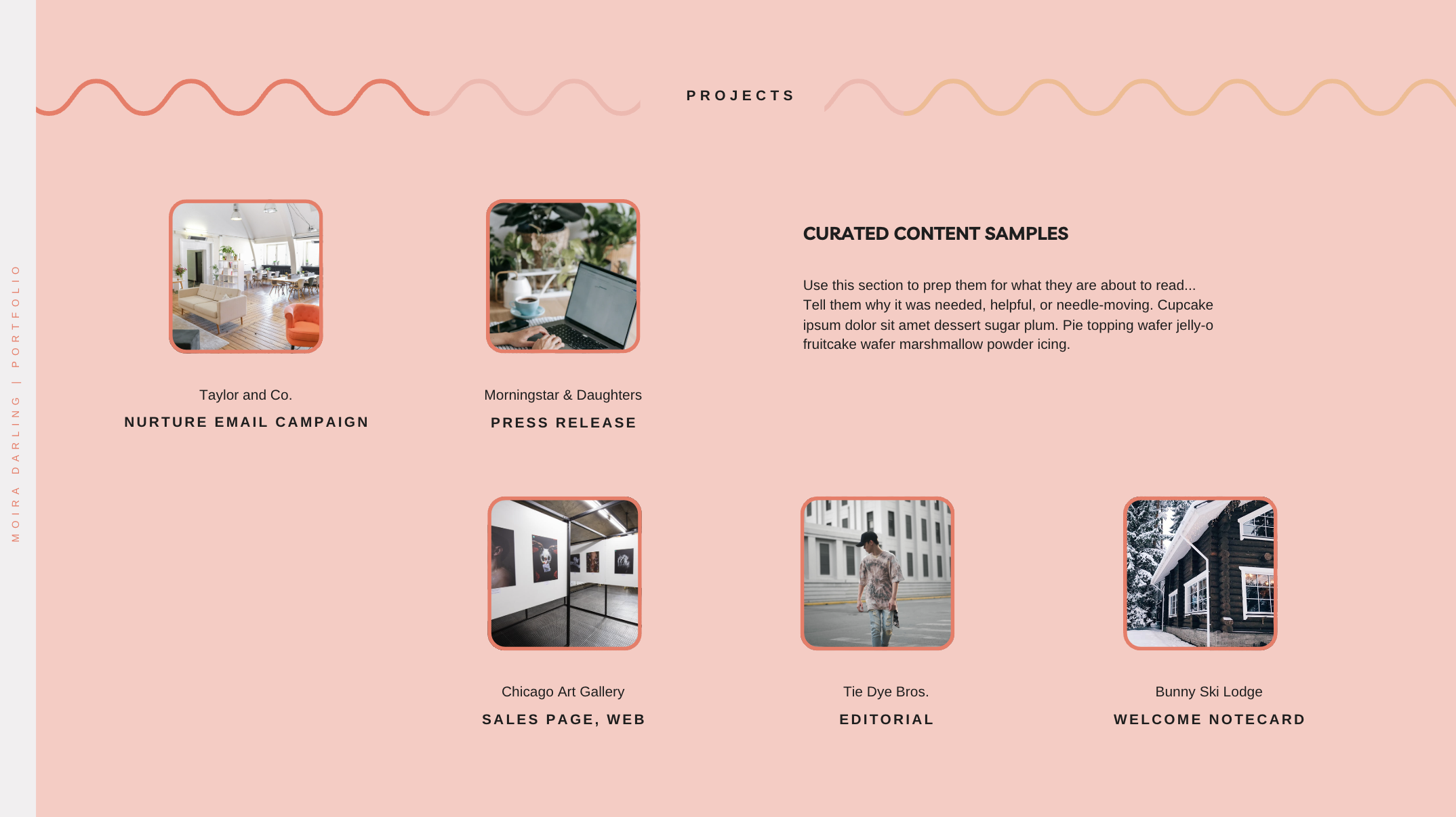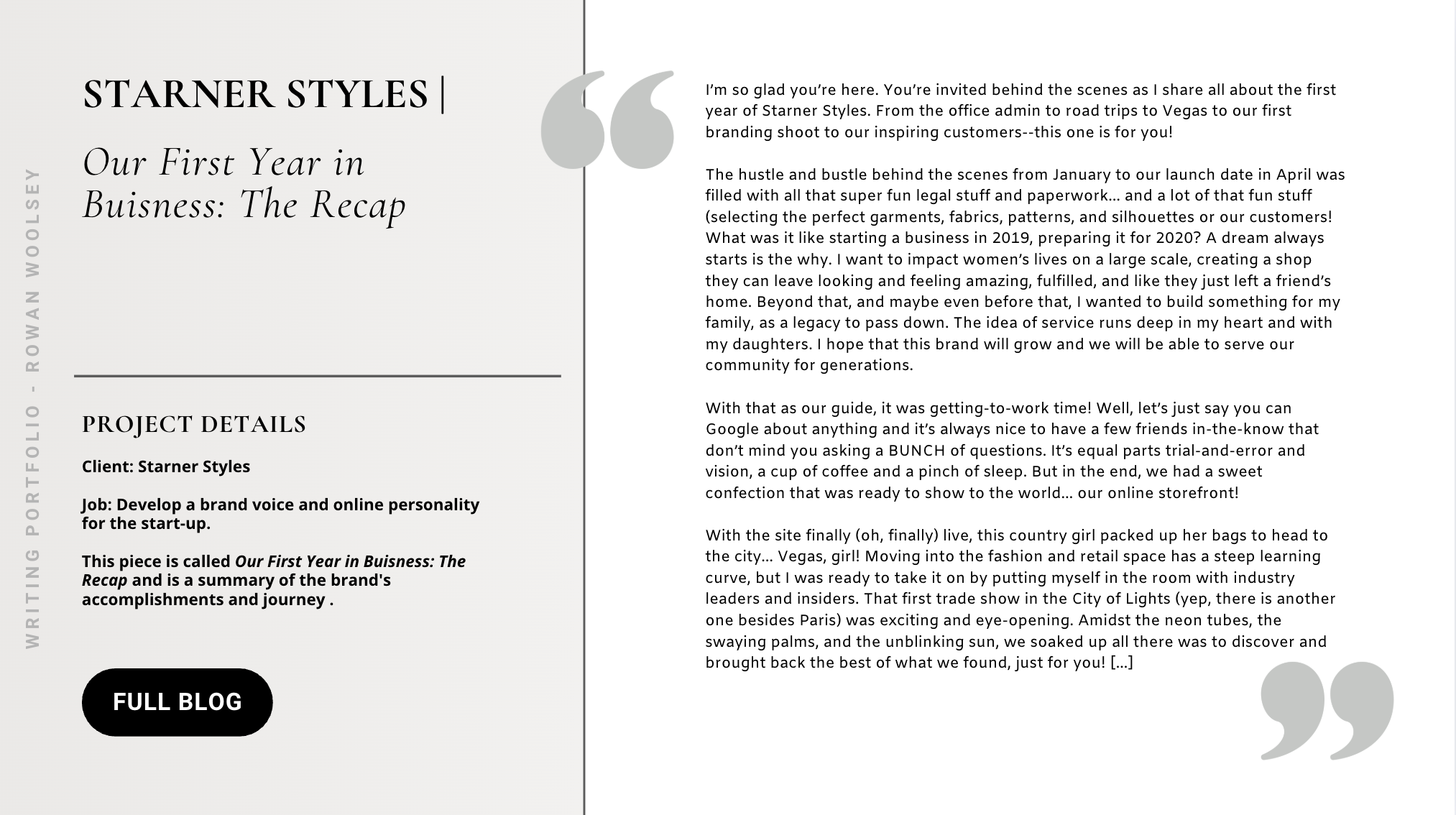5 Fatal portfolio mistakes and 1 thing that fixes all of them
There’s a power lever most people are ignoring when it comes to building their portfolios. Overlooking it gets you overlooked, too. Once you know about it, it organically fixes all the fatal mistakes and your portfolio starts being the opportunity magnet it should be.
Before we discuss the 5 fatal portfolio mistakes, we need to talk about the cheat code that addresses all of them. When you build or rework your portfolio, think about this one thing, first. Once you discover it, don’t let it’s simplicity fool you. It’s a game-changer.
One of the guiding principles of copywriting is putting yourself in your audience’s shoes. When you’re brand new with little or no experience, the BEST place to put this into practice is your own portfolio.
When talking about your portfolio, your audience is made up of:
Recruiters
Clients
Hiring managers
We’re going to call these people your “target persona.” It’s through this persona’s eyes that you’re going to filter every decision you make for your portfolio…
What to include in your portfolio
How you’re going to frame things
What additional elements besides samples, if any, you’ll include
This is an exercise in audience research and empathy… I like to start by getting to know my audience’s agenda, common frustrations, and the main pain point they are trying to solve. Once I know these things, I can curate everything to address those concerns.
What your target persona is doing/thinking/feeling…
Filtering through dozens or hundreds of not-so-great candidates
Maybe have spent months or even years trying to find a talented writer
Even if they find a qualified writer, does that writer “get” them and their brand, product, or mission?
Think about this for a minute. What emotions are they experiencing? Emotions can run the gamut making your audience…
Exhausted
Desperate
Jaded
Hopeful
Motivated
Energized
When I think about this range of emotions and their challenges with finding a qualified writer who “gets” them, who can execute projects… Now I know I need to:
Be clear in what I can do (content types, skills)
Demonstrate technical expertise (formatting, grammar, style)
Show I have a point of view as a writer (Explain my process or approach to writing)
Storytelling (Hooks, headlines, calls to action, and content)
Remove risk (good quality samples, testimonials, client feedback, colleague shoutouts, etc.)
This is your mindset going into your portfolio build. This point of view will help you tell a succinct yet powerful story through your portfolio, checking all the boxes for your most ideal clients and companies.
With this in mind, let’s address the 5 fatal portfolio mistakes writers are making right now.
Fatal mistake 1: Too many samples
Too many samples will overwhelm your reader. They won’t know which is the best one to review. Seeing too many might even trigger decision fatigue that will have them clicking away from your portfolio, never to return.
Too many samples are overwhelming and work against you. Would you know where to start, if you were seeing this for the first time?
Portfolios should NEVER be everything you ever wrote (unless you only have a handful). Instead, you should think about how to curate your samples. Include just enough to prove your point (you are a great blog writer, for example) and nothing more that could confuse the reader or lead the reader down a bunny trail.
A curated selection of your best work. Much easier to review for everyone.
👉Select a few samples that demonstrate your expertise in any particular content type, based on your career goal.
Fatal mistake 2: No focus or message
Your portfolio should tell a story… Of you, your skills, and what kind of content you write. But when you only have a bunch of random links and no organization, it becomes difficult for anyone else to understand exactly who you are and what you can do for them.
Messaging is…the curated story you tell your audience.
Here are some questions you can ask yourself that will help you figure out what message you want your reader to walk away with…
Are you a specialist in a certain kind of writing/do you want to be? Or are you a generalist?
What content do you definitely not want to write?
Do you have experience or insights in a certain industry?
Do you have special interests that influence what sort of companies you want to write for?
Are there social or environmental movements you want to support with your words?
What is unique about you or your background that makes you a good writer?
👉 Once you start exploring what you really want to accomplish with your writing and the type of writing you want to do, three things happen around your messaging:
Create a powerful writer profile
Select appropriate writing samples that align with your talent and goals
Identify samples that do not belong in your portfolio
Fatal mistake 3: No context / why should we care?
Without context, your content is worthless.
Think about sharing your work from the target persona’s point of view… They don’t know who you are. They aren’t familiar with your professional history. They have no idea what part you played in the sample they’re seeing… And they have no idea if what they’re looking at is any good.
You cannot leave your value up to interpretation. Literally spell it out.
The way you do this in your portfolio? Project briefs, baby!
You need to communicate things:
What part you played
Why it matters
👉 Explain everything your audience needs to know by including a project brief. You can get very detailed or use a simplified version.
Here’s the simplified version:
Challenge/Goal
Solution/Plan
Your role
Outcome
I think the more detailed you get here, the better the recruiter (ahem, target persona) understands you and your content. More importantly, it helps them understand your value… which is the whole point.
You can explain the company’s goal to overcome a particular challenge or implement its content calendar. You can explain whatever the plan was to solve the problem and your role in the writing sample you’re sharing.
Like this…
With this context, the target persona can better understand the choices you made, how closely it matches the brief, and why the content matters in the first place.
Need to build more credibility?
Tie the project to a goal like building audience awareness or driving subscriptions. This way, the reader gets why the content had an impact on the business… and how you’re helping to solve problems.
So, you didn’t just write a homepage for a tech support company. You developed an approachable brand voice that first, sets them apart from every other tech support company out there, and second, helps their ideal customer feel comfortable reaching out and working with them.
See? Relevant context that matters to the reader.
Here’s how I’d create a project brief about this for my portfolio...
Fatal mistake 4: Nothing to differentiate you
When pitching or applying for jobs, you are one person in a sea of applicants. Think about how you are going to:
Stand out
Magnetize great clients and opportunities
👉 To do this, you need to blend your technical skills with what makes you unique to develop grabby language for your portfolio and LinkedIn. This is where lots of people get stuck, because it takes self-relfection. And that’s hard and sometimes painful.
I want to give you a few ideas to figure out what makes you unique and frame it so great clients and companies will self-select you as their ideal writer.
Review your resume. Are there patterns or similarities in your work style from job to job? This could hint at a signature process.
Mine for feedback. Whether you’ve faithfully kept a hype file or need to dig through email or Slack, try to find as many communiques about you. Shoutouts, annual reviews, awards, and more can tell you something about your soft skills, work style, and more.
Daydream. When you think about your ideal (career) future, what comes up? Are you collaborating with clients, hosting creative meetings, or working in secluded silence? This can tell you how to position yourself in your biography, taglines, and other branding materials (like you’re highly collaborative or you excel at solo assignments, for example).
You can use this self-reflection to build your writer biography and to develop a tagline (a part of your basic branding that I talk about in this blog.)
Once you figure out what makes you unique, you can apply it to your:
Cover letter
Resume headline
LinkedIn subheader
Portfolio headline
Portfolio/website bio
Fatal mistake 5: Broken links
Nothing breaks trust faster than a broken link. A recruiter is interested enough to actually READ your content, they click on that link, aaaand it leads to a broken link 😬 Yikes. Not a good look.
There are two things to ensure this never happens to you.
Don’t share live links from websites you don’t own.
If you have content that’s been published on a website, you might want to share that direct link. DO NOT do that. You don’t own that site. That content can be changed at any point, which means it doesn’t reflect your style or best work anymore. It also can be deleted.
👉 Instead, take a screenshot of your content to share in your portfolio and link to the original Google Document YOU own.
Make sure your permissions are set to “Anyone with the link > Can view.”
2. Include clips of your content directly in your portfolio so if there IS an issue with the link, the reader can still read a sample of your work.
Let me share a sample from my first-ever portfolio as a visual example…
Portfolio page with: Project description, link to the original Google Doc that’s in my G-Drive, a writing sample excerpt.
Create your portfolio
If you want to put these ideas into action, I recommend you check out my Copywriter Portfolio Start Kit.
Not only will it guide you step by step through creating a professional-grade portfolio in Google Drive, but it will also help you show off your best qualities and help you differentiate yourself from every other writer out there.
The Portfolio Dashboard, a short document you’ll use as your portfolio, houses your content samples alongside your…
Writer bio with a prompt
Sections for a case study
Client or peer testimonials
And more.









